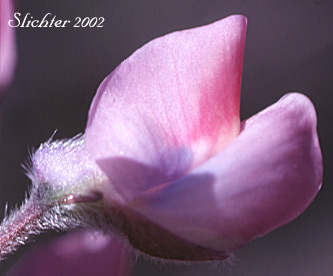Synonyms: Lupinus caudatus, Lupinus caucatus var. caudatus, Lupinus hendersonii
Kellogg's spurred lupine observed near the mouth of the Deschutes River in the Deschutes River State Recreation Area...........April 7, 2024.
Kellogg's spurred lupine observed near the mouth of the Deschutes River in the Deschutes River State Recreation Area...........April 7, 2024.
 The photo at right shows a close-up of the flower of Kellogg's
spurred lupine. Although virtually indistinguishable from spurred lupine (Lupinus
laxiflorus), the former lacks minute hairs which are found atop each wing petal,
directly below the banner. Photographed near the mouth of the Deschutes River........March
30, 2002.
The photo at right shows a close-up of the flower of Kellogg's
spurred lupine. Although virtually indistinguishable from spurred lupine (Lupinus
laxiflorus), the former lacks minute hairs which are found atop each wing petal,
directly below the banner. Photographed near the mouth of the Deschutes River........March
30, 2002.
Kellogg's spurred lupine is an attractive perennial wildflower with an unsettled taxonomy. It is very similar in appearance to spurred lupine (Lupinus laxiflorus), and is easily confused witht the latter species. Complicating matters is the fact that both species are often found together.
Hitchcock, in his "Flora of the Pacific Northwest" classifies Kellogg's spurred lupine as Lupinus caudatus. Current nomenclature lists it as Lupinus arbustus ssp. neolaxiflorus. I'd imagine the taxonomy of this species is still being considered and perhaps open for further revision.
The several stems of Kellogg's spurred lupine range from simple to branched and range from 20-35 cm tall. The herbage consists of silvery, silky, straight hairs closely appressed to the stem or leaves, all pointing in the same direction. Basal leaves may or may not be present. If so, the petioles range from 2-2.5 times longer than the blades. The petioles of the upper stem leaves are usually shorter than the leaf blades. Individual leaves are palmately compound with 6-10 leaflets, each of which ranges from narrowly to broadly oblanceolate. Individual leaflets range from 3-5 cm long with pointed tips and with silky hairs on both leaf surfaces.
The racemes range from 5-30 cm long with many flowers. Spacing of the flowers ranges from closely packed (somewhat reminiscent of Lupinus leucophyllus) to widely spaced. The flower stems range from 2-3 mm long. Individual flowers are 10-12 mm long. The calyx which measures 3-4 mm long is slightly to prominently spurred on the upper side above the petiole. The upper calyx lobe is split at its tip, and ranges from 1/3 to 3/4 the length of the wings of the corolla (See photo below.). The corolla ranges from blue, purple, poink or white in color. The banner often is marked with white or yellowish on the front and has some short hairs on its back. The wings are glabrous (as opposed to being minutely pubescent on their upper surface as in Lupinus laxiflorus) or entirely lacking hairs. The margins of the keel are fringed with minute hairs. The silky pods are 2-3 cm long. The 4-6 seeds are about 5 mm long and a pinkish-brown in color.
Kellogg's spurred lupine may be found on sagebrush slopes or in ponderosa pine forests.
Kellogg's spurred lupine may be found from central Oregon east to Montana and Colorado and south to California.
Kellogg's spurred lupine is not officially acknowledged as being found in the Columbia River Gorge but some plants may be found east of The Dalles, OR.